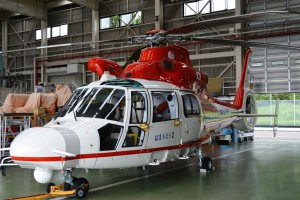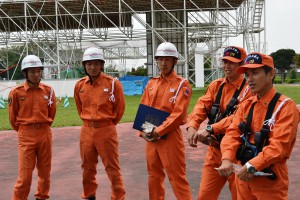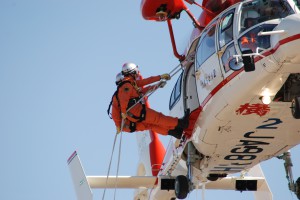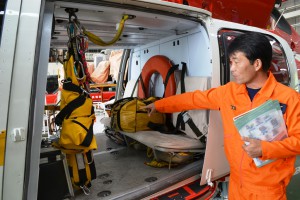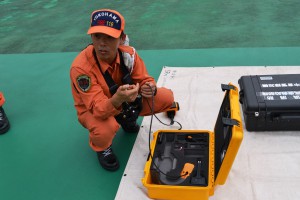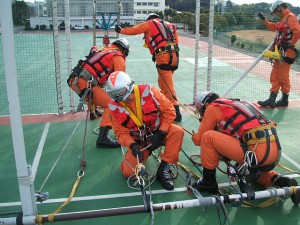Date : November 7, 2014
Notice: Yokohama Press Tour “Behind the Scenes of Disaster Rescue Initiatives in the Birthplace of Rescue Teams in Japan”
post date : 2014.10.17
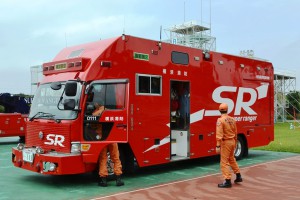 Natural disasters are always present in Japan, as evidenced by the Great East Japan Earthquake, Hiroshima landslides, the eruption of Mt. Ontake, and landfall of major typhoons.
Natural disasters are always present in Japan, as evidenced by the Great East Japan Earthquake, Hiroshima landslides, the eruption of Mt. Ontake, and landfall of major typhoons.
When disasters strike in Japan, rescue team members wearing immediately recognizable orange uniforms rush to the scene to start search and rescue efforts.
Rescue teams in Japan began with the 1964 establishment of the Yokohama Rangers in Yokohama City. With the rapidly changing urban landscape due to post-war development, an increased necessity of rescue operations for a variety of accidents was predicted, and so Yokohama City sent fire department members to a Japan Ground Self-Defense Force school to provide them with “ranger training,” which is known to be very hard. In particular, the elite Super Ranger team uses specialized vehicles and equipment to respond to large-scale disasters. Their activities are not limited to Yokohama: they participated in rescue operations after the Great East Japan Earthquake, were dispatched to the site of the Fukushima Daichi accident, and have also gone overseas as part of international emergency rescue efforts.
According to the UN classification of international search and rescue teams, Japan is classified as a Heavy Team, the highest rank.
This press tour will visit Yokohama, where the first Japanese rescue team was established, and cover the various types of training that help team members maintain their advanced rescue skills. Yokohama is also the first municiparity in Japan to implement call triage (triage=determining severity/urgency of patients). This press tour will cover initiatives such as these that make Yokohama City a leader in Japan when it comes to preparation for large-scale disasters and accidents.
*This press tour is sponsored by Yokohama City, with planning cooperation provided by the FPCJ.
*Participants will have to cover part of the cost of this press tour, but it is not a profit-making enterprise.
***************************************************************************
<Tour Details>
1. Yokohama City Fire Department Air Corps & Hamachidori Firefighting Helicopters
 The Yokohama City Fire Department Air Corps has two helicopters, Hamachidori 1 (from an Italian manufacturer) and Hamachidori 2 (French manufacturer). When disasters occur, these helicopters are flown to the scene to participate in rescue efforts, transporting emergency patients, firefighting or gathering information. The helicopters are also dispatched to large-scale disasters outside Yokohama, such as the 1995 Great Hanshin Earthquake, 2004 Niigata Chuetsu Earthquake, the 2011 Great East Japan Earthquake, and the 2013 landslide in Izu Oshima.
The Yokohama City Fire Department Air Corps has two helicopters, Hamachidori 1 (from an Italian manufacturer) and Hamachidori 2 (French manufacturer). When disasters occur, these helicopters are flown to the scene to participate in rescue efforts, transporting emergency patients, firefighting or gathering information. The helicopters are also dispatched to large-scale disasters outside Yokohama, such as the 1995 Great Hanshin Earthquake, 2004 Niigata Chuetsu Earthquake, the 2011 Great East Japan Earthquake, and the 2013 landslide in Izu Oshima.
The new Hamachidori 1 helicopter introduced in 2013 has significantly improved engine output and flight distance over the previous model. With advanced hovering capabilities and the capacity to rescue 12 people at once, the introduction of this latest model significantly improved the Air Corps rescue capabilities.
◎The tour will visit Yokohama Heliport, the base of operations for the Yokohama City Fire Department Air Corps. After observing/photographing aerial rescue training (hoisting, rappelling) using one of the Hamachidori firefighting helicopters, interviews will be held with the pilots and other firefighters.
*If a disaster or accident occurs during the tour, it may not be possible to cover the helicopter training if the Hamachidori is part of the response
*Tour coverage will be of the Hamachidori 2 (the older model). The new model Hamachidori 1 is undergoing a periodic maintenance check at a factory.
2. Special Advanced Rescue Team “Super Rangers”
An elite team that helped after the Great East Japan Earthquake
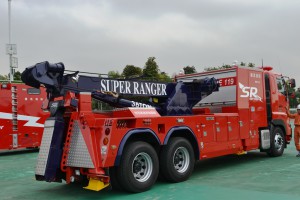 The Special Advanced Rescue Team, known as the Super Rangers, was created in 2008 to fulfill a general role during major disasters and to respond to special disasters including NBC (nuclear, biological, chemical) disasters. The Yokohama Rangers* Special Rescue Team, created in 1964 as the first specialized rescue team in Japan, selects its members from the top firefighters in the city. Super Rangers members are then chosen from the Yokohama Rangers, making them the best of the best. Requirements to become a Super Ranger include experience in the Yokohama Rangers and passing special training. Members have ample experience in and knowledge of search and rescue, in addition to their physical and mental fortitude. After the Great East Japan Earthquake on March 11, 2011, they participated in search and rescue efforts in Sendai, Miyagi and also arrived in Fukushima on March 22 to spray water to cool down the Fukushima Daiichi Unit 3 Reactor.
The Special Advanced Rescue Team, known as the Super Rangers, was created in 2008 to fulfill a general role during major disasters and to respond to special disasters including NBC (nuclear, biological, chemical) disasters. The Yokohama Rangers* Special Rescue Team, created in 1964 as the first specialized rescue team in Japan, selects its members from the top firefighters in the city. Super Rangers members are then chosen from the Yokohama Rangers, making them the best of the best. Requirements to become a Super Ranger include experience in the Yokohama Rangers and passing special training. Members have ample experience in and knowledge of search and rescue, in addition to their physical and mental fortitude. After the Great East Japan Earthquake on March 11, 2011, they participated in search and rescue efforts in Sendai, Miyagi and also arrived in Fukushima on March 22 to spray water to cool down the Fukushima Daiichi Unit 3 Reactor.
*Yokohama City was the first local government to establish a search and rescue team. Therefore, the city received many requests from across Japan for search and rescue training.
◎The tour will first hear an overview of the Super Rangers and their activities (including search and rescue efforts after the Great East Japan Earthquake) from team leader Eikichi Sakuma. Then the tour will observe/photograph the Super Rangers specialized vehicles and equipment, and training for rescuing people trapped on sandbars or in rubble.
*If a disaster or accident occurs during the tour, it may not be possible to cover the special vehicles if they are part of the response.
3. Yokohama Emergency System- Call Triage
Quickly judging urgency and severity to use limited emergency resources effectively
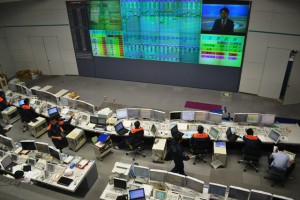 As the population ages, the demand for emergency services in Japan continues to increase. In 2012, emergency services were dispatched about 5.8 million times throughout Japan, more than ever before. With a population of 3.7 million, Yokohama City is no exception. With the number of emergency service dispatches increasing by approximately 16 % for 10 years from 2002 to 2012. Even before 2002, the demand for emergency services was on the increase, and amid concerns that in urgent cases the arrival of emergency cars may be delayed, there were calls for some measures to dispel the concerns.
As the population ages, the demand for emergency services in Japan continues to increase. In 2012, emergency services were dispatched about 5.8 million times throughout Japan, more than ever before. With a population of 3.7 million, Yokohama City is no exception. With the number of emergency service dispatches increasing by approximately 16 % for 10 years from 2002 to 2012. Even before 2002, the demand for emergency services was on the increase, and amid concerns that in urgent cases the arrival of emergency cars may be delayed, there were calls for some measures to dispel the concerns.
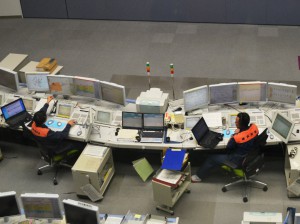 In this situation, Yokohama started using call triage (a program to determine severity/urgency) in 2008 as the basis for their emergency system. Triage determines the severity and urgency of patient conditions, and ranks them to prioritize their transportation and treatment. Normally, triage is performed on site, but Yokohama City has developed a system where upon receiving an emergency call, an emergency dispatcher with specialized knowledge and skills will classify the urgency and severity of the patient using five ranks, and dispatch an appropriate emergency response team. In cases of limited severity or urgency, smaller teams are dispatched. In cases of great severity or urgency, large rescure teams including emergency medcal technicians and firefighters are dispatched immediately. Since introducing this system, average response times to severe or urgent cases in Yokohama City are now almost one minute faster than the general response time.
In this situation, Yokohama started using call triage (a program to determine severity/urgency) in 2008 as the basis for their emergency system. Triage determines the severity and urgency of patient conditions, and ranks them to prioritize their transportation and treatment. Normally, triage is performed on site, but Yokohama City has developed a system where upon receiving an emergency call, an emergency dispatcher with specialized knowledge and skills will classify the urgency and severity of the patient using five ranks, and dispatch an appropriate emergency response team. In cases of limited severity or urgency, smaller teams are dispatched. In cases of great severity or urgency, large rescure teams including emergency medcal technicians and firefighters are dispatched immediately. Since introducing this system, average response times to severe or urgent cases in Yokohama City are now almost one minute faster than the general response time.
◎The tour will visit the Yokohama City Fire Department Command Center and listen to an overview of call triage in the Yokohama emergency system, before observing dispatchers actually using the system.
4. Midori Fire Department
Base of operations for firefighters standing by for dispatch 24/7
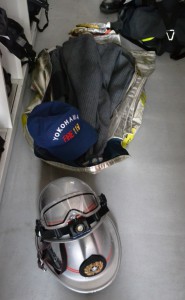 The Midori Fire Department (Midori-ku, Yokohama) just moved to a new building in August of this year. In addition to offices, sleeping quarters, a kitchen and shower room, the building also has search and rescue training facilities. While the firefighters stay on standby to move out at any time, they also train daily to improve their rescue skills and their physical condition, through fighrefithing and rescue operaion drills and weight training. When the order comes for dispatch, firefighters can change in to their gear and leave in the fire engine in just one minute.
The Midori Fire Department (Midori-ku, Yokohama) just moved to a new building in August of this year. In addition to offices, sleeping quarters, a kitchen and shower room, the building also has search and rescue training facilities. While the firefighters stay on standby to move out at any time, they also train daily to improve their rescue skills and their physical condition, through fighrefithing and rescue operaion drills and weight training. When the order comes for dispatch, firefighters can change in to their gear and leave in the fire engine in just one minute.
According to the city’s Fire Department, in addition to this daily training, “Instructing local communities about disaster-management measueres, instructing businesses about firefighting equipment, carrying out periodic inspections, and cooperating with volunteer firefighting brigades are all part of the unique Japanese attention to detail in fire prevention initiatives, creating a safe and secure society.”
◎The tour will visit Midori Fire Department, the firefighters’ base of operations, and observe an emergency response drill conducted by the firefighters.
< Tour itinerary and application details >
1. Itinerary (Tentative): Friday, November 7, 2014
9:40 Meet at Shidai-Igakubu Station (Yokohama Seaside Line)
9:40-10:00 Move by chartered bus
10:00-11:00 Yokohama City Fire Department Air Corps& Hamachidori Firefighting Helicopters
11:00-12:15 Move by charterd bus and lunch (on the bus)
12:15-13:45 Special Advanced Rescue Team “Super Rangers”
13:45-14:30 Move by chartered bus
14:30-15:30 Yokohama Emergency System- Call Triage
15:30-16:15 Move by chartered bus
16:15-17:00 Midori Fire Department
17:10 Break up on the spot (the nearest station is JR Nakayama)
2. Qualification: Bearer of Gaimusho Press Registration Card
3. Cost: 1,500 yen per person including lunch
* FPCJ will later inform the participants of methods for payment, cancellation fee etc.
4. Participants: Limited to 10 applicants.
(Only one reporter and one photographer from each company, but two participants from each TV team will be acceptable.)
5. FPCJ Contact: Ms. Ishikawa and Ms. Obo (Tel: 03-3501-3405)
6. Remarks:
(1) There may be some restrictions on photographing and filming at the tour sites. Please follow the instructions of the officials on duty.
(2) Yokohama City and FPCJ will not be liable for any inconvenience, trouble or accident that might occur during the tour.




